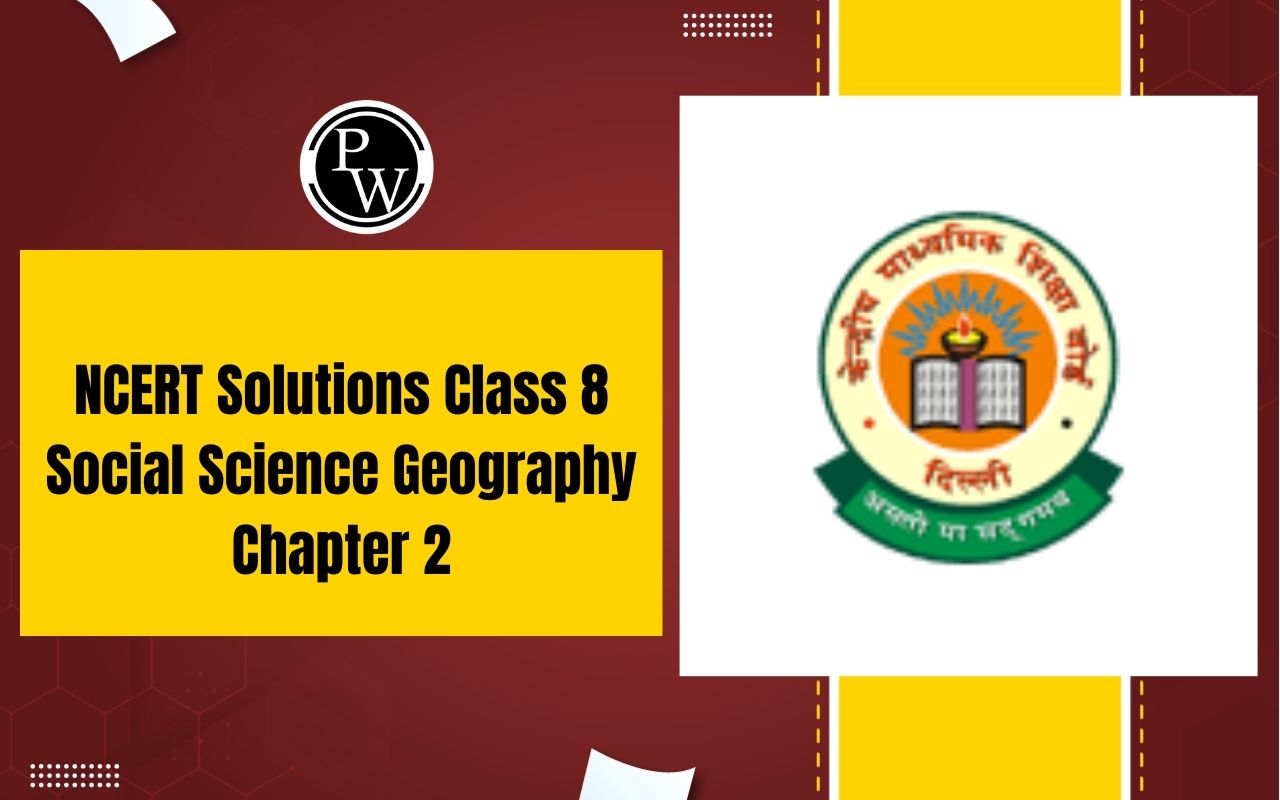
NCERT Solutions for Class 8 Social Science Geography Chapter 2: Chapter 2 of Class 8 Social Science Geography is all about "Land, Soil, Water, Natural Vegetation, and Wildlife Resources." In this chapter, you'll learn how important things like land, soil, and water are for people.
It also talks about why plants and animals are essential for our environment. By understanding these topics, you'll see how nature and people depend on each other.NCERT Solutions for Class 8 Social Science Geography Chapter 2 Overview
These solutions were created by experts at Physics Wallah to help students understand Chapter 2 of Class 8 Social Science Geography. This chapter is about "Land, Soil, Water, Natural Vegetation, and Wildlife Resources." By using these solutions, students can learn more about how these resources are important for life on Earth. The solutions explain things clearly, step by step, so students can understand them better and improve their geography knowledge.NCERT Solutions for Class 8 Social Science Geography Chapter 2 PDF
You can find the PDF link for NCERT Solutions Class 8 Social Science Geography Chapter 2 below. This PDF contains detailed solutions prepared by subject experts to help you understand the concepts covered in the chapter.NCERT Solutions Class 8 Social Science Geography Chapter 2 PDF
NCERT Solutions for Class 8 Geography Chapter 2 – Land, Soil, Water, Natural Vegetation and Wildlife Resources
Below are the solutions for NCERT Class 8 Geography Chapter 2 – Land, Soil, Water, Natural Vegetation, and Wildlife Resources. By referring to these solutions, students can deepen their understanding of topics related to land, soil, water, natural vegetation, and wildlife resources, thereby enhancing their knowledge and academic performance.1. Answer the following questions.
(i) Which are the two main climatic factors responsible for soil formation?
Answer: The formation of soil is primarily influenced by two main climatic factors: temperature and rainfall. Among these, rainfall plays a significant role in determining the rate of weathering and the formation of humus in the soil. Adequate rainfall accelerates the process of weathering, which breaks down rocks into smaller particles over time.
This process contributes to the formation of soil by gradually decomposing rocks and minerals. Rainfall aids in the decomposition of organic matter, such as fallen leaves and plant debris, which enriches the soil with humus—a crucial component for soil fertility. Therefore, both temperature and rainfall are essential climatic factors that shape the formation and composition of soil.(ii) Write any two reasons for land degradation today.
Answer: The excessive use of chemical fertilizers and the widespread practice of deforestation are the primary causes of land degradation. As the population continues to grow, there is an increasing demand for resources, resulting in the large-scale destruction of forest cover and arable land.
This rampant exploitation of natural resources poses a significant threat to the environment and ecosystem. It leads to soil erosion, loss of biodiversity, and decreased soil fertility, ultimately jeopardizing the sustainability of land resources. Urgent measures are required to address these issues and promote sustainable land management practices to mitigate the adverse effects of land degradation.(iii) Why is land considered an important resource?
Answer: Land is recognized as a crucial resource due to its versatility and multiple uses. It serves as a foundation for various activities essential for human civilization, including agriculture, forestry, mining, urban development, infrastructure construction such as roads, and establishment of industries.
The significance of land lies in its ability to support life by providing space for cultivation, habitation, and economic activities. Its proper utilization and management are paramount for sustainable development and ensuring the well-being of present and future generations.(iv) Name any two steps that the government has taken to conserve plants and animals.
Answer: The government has implemented significant measures to safeguard and preserve plants, animals, and natural vegetation.
Firstly , it has established national parks, wildlife sanctuaries, and biosphere reserves to provide protected habitats for diverse species and ecosystems. These designated areas serve as crucial conservation zones where human activities are regulated to minimize disturbance to flora and fauna.
Secondly , awareness initiatives such as social forestry programs and tree plantation campaigns like 'Vanamahotsava' have been undertaken to promote forest conservation. These efforts aim to raise public awareness about the importance of forests and encourage active participation in reforestation and afforestation activities.
Through these concerted actions, the government seeks to ensure the sustainability and vitality of our natural resources for the benefit of present and future generations.(v) Suggest three ways to conserve water.
Answer: Conserving water is crucial for sustainable resource management. Here are three main strategies to achieve this:
a. Increasing forest cover and vegetation : Dense vegetation, including forests and grasslands, helps slow down surface runoff by absorbing rainwater and allowing it to infiltrate into the soil. This process reduces soil erosion and helps recharge groundwater aquifers, ultimately conserving water resources. b. Rainwater harvesting : Implementing rainwater harvesting techniques allows for the collection and storage of rainwater, which can then be used for various purposes such as irrigation, household chores, and groundwater recharge. This practice helps replenish underground water sources and reduces dependency on surface water reservoirs. c. Adopting water-efficient agricultural practices : Farmers can reduce water consumption in agriculture by employing techniques such as drip irrigation, mulching, and crop rotation. These methods minimize water loss through evaporation and runoff, ensuring that water is used more efficiently in crop production. Shifting to less water-intensive crops and sustainable farming practices can further conserve water resources and promote ecological balance.2. Tick the correct answer.
(i) Which one of the following is NOT a factor of soil formation?
(a) Time (b) Soil texture (c) Organic matterAnswer : b. Soil Texture
(ii) Which one of the following methods is most appropriate to check soil erosion on steep slopes?
(a) Shelterbelts (b) Mulching (c) Terrace cultivationAnswer: c) Terrace cultivation
(iii) Which one of the following is NOT in favour of the conservation of nature?
(a) switch off the bulb when not in use (b) close the tap immediately after using (c) dispose poly packs after shoppingAnswer: c) Dispose poly packs after shopping
3. Match the following.
| Column A | Column B |
| Land use | prevent soil erosion |
| Humus | narrow zone of contact between the lithosphere, hydrosphere and atmosphere |
| Rock Dams | productive use of land |
| Biosphere | organic matter deposited on top soil |
| contour ploughing |
Answer:
| Column A | Column B |
| Land use | productive use of land |
| Humus | organic matter deposited on top soil |
| Rock Dams | prevent soil erosion |
| Biosphere | narrow zone of contact between the lithosphere, hydrosphere and atmosphere |
(i). Ganga–Brahmaputra plain of India is an overpopulated region.
True
(ii) Water availability per person in India is declining.
True
(iii) Rows of trees planted in the coastal areas to check the wind movement are called intercropping.
False
(iv) . Human interference and changes of climate can maintain the ecosystem.
False
Chapter 2 – Land, Soil, Water, Natural Vegetation and Wildlife Resources Summary
Chapter 2 of "Land, Soil, Water, Natural Vegetation, and Wildlife Resources" discusses various resources essential for life on Earth. It covers the significance of abiotic resources like land, soil, and water, along with biotic resources such as natural vegetation and wildlife. The chapter examines factors influencing land distribution and population density, including topography, climate, and human settlement patterns. It addresses water scarcity issues and advocates for conservation measures. The chapter emphasizes the preservation of natural vegetation and wildlife through initiatives like protected areas and awareness campaigns. Overall, Chapter 2 highlights the critical role of these resources and the necessity of sustainable management for environmental well-being.Benefits of NCERT Solutions for Class 8 Social Science Geography Chapter 2
- Clarity: The solutions provide clear explanations and answers to the questions in the textbook, helping students understand the concepts better.
- Comprehensive Coverage: Each topic is covered comprehensively, ensuring that students have a thorough understanding of the subject matter.
- Structured Approach: The solutions follow a structured approach, making it easier for students to follow along and grasp the concepts systematically.
- Conceptual Understanding: By providing detailed explanations, the solutions help students develop a strong conceptual understanding of the topics covered in Chapter 2.
NCERT Solutions for Class 8 Social Science Geography Chapter 2 FAQs
Why is land considered one of the most important natural resources?
What factors influence soil formation?
How does water availability impact land use and population distribution?
What are the consequences of land degradation?
What measures can be taken to conserve water resources?













